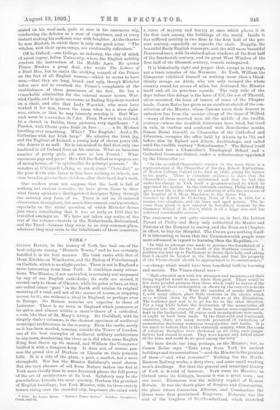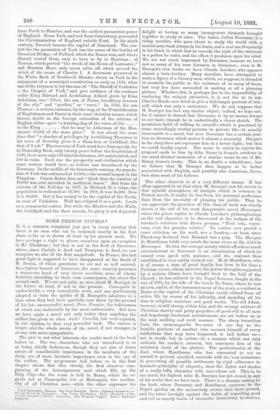YORK.*
'CANON RAINS, in the history of York, has had one of the best subjects among "Historic Towns," and he has certainly handled it in the best manner. His book ranks with that of Dean Kitchin on Winchester, and the Bishop of Peterborough on Carlisle, which is no slight praise. There is not in England a more interesting town than York. It combines many attrac- tions. The Minster, if not unrivalled, is certainly not surpassed by any of our English cathedrals ; its walls are second, if second, only to those of Chester, while its gates or bars, as they are called (since " gate " in the North still retains its original meaning of a road, and not of the means of access, or stopping access, to it), are without a rival in England, or perhaps even in Europe. Its Roman remains are superior to those of Leicester. There is no town in England which possesses at its gates, and almost within a stone's-throw of a cathedral, a ruin like that of St. Mary's Abbey. Its Guildhall, with its -shapely timber columns, is the choicest specimen of mediaeval municipal architecture in the country. Even the castle, sorely as it has been mauled, remains, outside the Tower of London, one of the best examples of mediaeval military architecture in any town, dominating the river as it did when some English King first threw up its mound, and William the Conqueror bridled it with a dungeon-keep. It does not, of course, pos- sess the grand site of Durham or Lincoln on their princely hills. It is a city of the plain, a port, a market, not a mere stronghold. Nor has the Minster Salisbury's rural charm. But the very absence of aid from Nature makes one feel at York more vividly than in more favoured places the full power of the art of architecture at its best. Salisbury may be the gracefullest, Lincoln the most queenly, Durham the grandest of English buildings ; but York Minster, with its three stately towers rising over the crowded city, impresses the mind with
* York. Bv James Rains. "Historic Towns Series." London : Longmans, Green, and Co.
a sense of majesty and beauty at once which places it in the first rank among the buildings of the world. Inside it has suffered terribly in two fires in the first half of the pre- sent century, especially as regards the choir. Happily, the beautiful Early English transepts, and the still more beautiful Decorated nave, with its stained-glass windows of the first half of the fourteenth century, and its great West Window of the first half of the fifteenth century, remain unimpaired.
It is historically right and proper that, except in the crypt, not a trace remains of the Normans. At York, William the Conqueror exhibited himself as nothing more than a blood- thirsty savage, an Attila who not only ravaged the whole country round for scores of miles, but destroyed the Minster itself and all its priceless records. The only relic of the days before this deluge is the horn of Ulf, the son of Thorald, silver-mounted, the horn of tenure of some of the Chapter lands. Canon Raine has given us an excellent sketch of the con- stitution of the Minster, whose Canons trace their descent in unbroken line from the secular clergy of the days of Wilfrid —many of them married men till the middle of the twelfth century—whom the monkish historians have tried, but tried in vain, to confuse and confound with Benedictine monks.
Canon Rains himself, as Chancellor of the Cathedral and Librarian, occupies the office held by Alcuin up to 782, and before him by Egbert and Albert, Archbishops, and called until the twelfth century "Schoolmaster." The School itself bifurcated into a Chancellor's Theological School and a Cathedral Grammar-School, under a schoolmaster appointed by the Chancellor :-
" In the so-called Chancellor's window in the nave, there is a representation of the Chancellor of the day, Robert Riplingham, of Merton College, Oxford (who died in 1332), giving his lecture to his pupils. There is abundant evidence to show that the Chancellor's class was long maintained, and that he had also under his charge in York itself a grammar-school to which he appointed the master. In the sixteenth century, Philip and Mary gave a new life to the school by endowing it with the revenues of
the hospital of S. Mary Magdalen in the Horse Fair founded by Robert do Pickering, Dean of York, in 1330, for a master, two chaplains, and six lame and aged priests. The in- come thus given is now enjoyed in hereditary descent by the Grammar School of St. Peter, which is of a large size, and has achieved considerable success."
The statement is not quite accurate, as, in fact, the Letters Patent of Philip and Mary only authorised the Master and
Patrons of the Hospital to convey, and the Dean and Chapter, in effect, to buy the Hospital. The Crown gave nothing itself. It is interesting to learn that the Commonwealth people were more advanced in regard to learning than the Royalists :—
" In 1652 an attempt was made to procure the foundation of a University at York for the benefit of the Northeru counties. A petition was sent up to Parliament to desire their help, and asking that it should be located in the Bedale, and that the property of the Vicars-choral should be appropriated to its maintenance,"
—a change which would have been beneficial both to learning and morals. The Vicars-choral were-
" Half-educated men with low pleasures and manners, and their living together would do more harm than good. There would be few more painful pictures than those which could be drawn of the depravity of these ecclesiastics as shown by the correction-books at the Minster Were the societies of monks different P I, with many others, place little credence in the stories which were written down by the Royal visitors at the Dissolution. The tendency just now is to go too far in the other direction. For a long while before the destruction of the monasteries, all inquiries into the character of their inmates were suppressed or kept in the background. Of course such investigations wore made, or ought to have been made. In the thirteenth and fourteenth centuries, there are many records preserved of visitations of monasteries disclosing numerous irregularities and faults. It is too much to believe that in the sixteenth century, when the cords of religious discipline were slackened on all sides, such irregu- larities had ceased to exist. They were known and talked about at the time, and could do no good among the laity."
We have dwelt too long, perhaps, on the Minster ; but, as Canon Raine says, "Take away from York its ancient buildings and its associations "—and the Minster is the greatest of them—" and what remains P " Nothing but the North- Eastern Railway works, a dirty river, and some small working men's dwellings. Not that the general and municipal history of York is devoid of interest. York owns its Minster, as
Oxford owns its Colleges, because it was a great town ; not vice versa. Eboracum was the military capital of Roman
Britain. It was the death-place of Sergius and Constantine, the place where Carauaius, Allectus, and Constantine the Great were first proclaimed Emperors. Eoforwic was the seat of the kingdom of Northumberland, which stretched
from Forth to Humber, and was the earliest paramount power of England. From York, and not from Canterbury, proceeded the Christianisation of England outside Kent. In the ninth century, Yorwick became the capital of Daneland. The con- test for the possession of York was the cause of the battles of Stamford Bridge ; of Fulford, which the Danes won, and where Harold routed them, only to have to fly to Hastings ; of Towton, which proved "the wreck of the House of Lancaster ;" and Marston Moor, only seven miles off, which proved the wreck of the cause of Charles I. A document preserved in the White Book of Southwell Minster shows us York in the enjoyment of a municipal constitution as early as 1106, when one of the jurymen to try the case of " The Sheriff of Yorkshire v. the Chapter of York," and give evidence of the customs under King Edward and Archbishop Aldred given by King Athelstan, was -Civet, the son of Porno, hereditary lawman of the city" and " prsefect" or " reeve." In 1130, his son Thomas—a curious instance, by-the-way, of the Frenchification of Englishmen and Danes in their sons' christian names, which throws doubt on the foreign extraction of the citizens of English cities—gave "a hunting-dog of the value of 20s to the King that he may be Alderman of the Mer- chants' Guild of the same place." It was about the same time that "a charter of privileges by Archbishop Thurstan to his town of Beverley gives it a Hans-hus, or Guildhall, like that of York." The recovery of York must have been speedy, for in Domesday Book, only twenty years before the Inquisition of 1106, there were only 509 inhabited houses, 400 uninhabited, and 500 in ruins. Such was the prosperity and civilisation which some writers would have us believe was introduced by the Normans. In the middle of the fourteenth century, the popula- tion of York was estimated at 10,800,—the second largest in the Kingdom. Canon Raine does not "think that the number of 10,800 was ever exceeded in mediaaval times." But from the returns of the Poll-tax in 1377, in Richard II 's reign, the population is reckoned at 13,690. In 1801, it was 16,000. Now it is 66,000. But it has ceased to be the capital of the North, or even of Yorkshire. Hull has eclipsed it as a port; Leeds as a commercial centre. But while the Minster and the Walls, the Guildhall and the Bars remain, its glory is not departed.



































 Previous page
Previous page